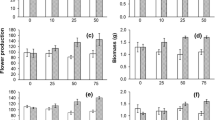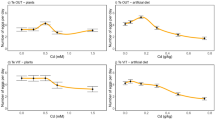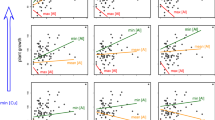Abstract
Metal hyperaccumulation is a striking trait exhibited by many plant species, but the evolutionary ecology of metal hyperaccumulation is poorly understood. It has been widely hypothesized that metal hyperaccumulation evolved to protect plants from herbivory. However, there is currently little evidence that metal hyperaccumulation enhances the fitness of plants in the presence of herbivory. In this study, we conducted a multi-factor greenhouse experiment to examine the effects of two soil nickel concentrations (unamended (0 μg/g) and nickel amended (600 μg/g)), and three levels of artificial damage (0, 10 and 50%) on the growth of plants from two populations of Thlaspi montanum var. montanum. We observed a significant interaction between soil nickel and artificial damage. An a posteriori analysis of this interaction revealed that the presence of nickel significantly improved the ability of T. montanum to tolerate the negative effects of intense damage. Our results indicate that metal hyperaccumulation could benefit T. montanum by increasing its tolerance to damage. This study suggests that there is a potential for the evolution of metal hyperaccumulation in response to intense herbivory on T. montanum.

Similar content being viewed by others
References
Baker AJM, Whiting SN (2002) In search of the Holy Grail–a further step in understanding metal hyperaccumulation? New Phytol 155:1–4
Basic N, Salamin N, Keller C, Galland N, Besnard G (2006) Cadmium hyperaccumulation and genetic differentiation of Thlaspi caerulescens populations. Biochem Systemat Ecol 34:667–677
Behmer ST, Lloyd CM, Raubenheimer D, Stewart-Clark J, Knight J, Leighton R S, Harper FA, Smith JAC (2005) Metal hyperaccumulation in plants: mechanisms of defence against insect herbivores. Funct Ecol 19:55–66
Boyd RS (2004) Ecology of metal hyperaccumulation. New Phytol 162:563–567
Boyd RS, Davis MA, Wall MA, Balkwill K (2002) Nickel defends the South African hyperaccumulator Senecio coronatus (Asteraceae) against Helix aspersa (Mollusca : Pulmonidae). Chemoecology 12:91–97
Boyd RS, Martens SN (1992) The raison d’etre for metal hyperaccumulation by plants. In: Baker AJM, Proctor J, Reeves RD (eds) The vegetation of ultramafic (Serpentine) soils. Intercept, Andover, UK, pp 279–289
Boyd RS, Martens SN (1994) Nickel hyperaccumulated by Thlaspi montanum var. montanum is acutely toxic to an insect herbivore. Oikos 70:21–25
Boyd RS, Martens SN (1998) Nickel hyperaccumulation by Thlaspi montanum var. montanum (Brassicaceae): a constitutive trait. Am J Botany 85:259–265
Boyd RS, Moar WJ (1999) The defensive function of Ni in plants: response of the polyphagous herbivore Spodoptera exigua (Lepidoptera : Noctuidae) to hyperaccumulator and accumulator species of Streptanthus (Brassicaceae). Oecologia 118:218–224
Brooks RR, Reeves RD, Jaffré T (1977) Detection of nickeliferous rocks by analysis of herbarium specimens of indicator plants. J Geochem Explor 7:49–77
Brooks R (1987) Serpentine and its vegetation. A multidisciplinary approach. Dioscorides Press, Portland
Brooks RR (1998) Geobotany and hyperaccumulators. In: Brooks R (eds) Plants that hyperaccumulate heavy metals. CAB International, Wallingford, pp 55–94
Coleman CM, Boyd RS, Eubanks MD (2005) Extending the elemental defense hypothesis: Dietary metal concentrations below hyperaccumulator levels could harm herbivores. J Chem Ecol 31:1669–1681
Fayiga AO, Ma LQ, Cao XD, Rathinasabapathi B (2004) Effects of heavy metals on growth and arsenic accumulation in the arsenic hyperaccumulator Pteris vittata L. Environ Pollut 132:289–296
Fornoni J, Núñez-Farfán J (2000) Evolutionary ecology of Datura stramonium: Genetic variation and costs for tolerance to defoliation. Evolution 54:789–797
Freeman JL, Garcia D, Kim DG, Hopf A, Salt DE (2005) Constitutively elevated salicylic acid signals glutathione-mediated nickel tolerance in Thlaspi nickel hyperaccumulators. Plant Physiol 137:1082–1091
Hanson B, Lindblom SD, Loeffler ML, Pilon-Smits EAH (2004) Selenium protects plants from phloem-feeding aphids due to both deterrence and toxicity. New Phytol 162:655–662
Holmgren P (1971) A biosystematic study of North American Thlaspi montanum and its allies. Mem New York Bot Gard 21:1–106
Huitson SB, Macnair MR (2003) Does zinc protect the zinc hyperaccumulator Arabidopsis halleri from herbivory by snails? New Phytol 159:453–459
Ingle RA, Smith JAC, Sweetlove LJ (2005) Responses to nickel in the proteome of the hyperaccumulator plant Alyssum lesbiacum. Biometals 18:627–641
Jhee E, Dandridge K, Christy A, Pollard A (1999) Selective herbivory on low-zinc phenotypes of the hyperaccumulator Thlaspi caerulescens (Brassicaceae). Chemoecology 9:93–95
Jhee EM, Boyd RS, Eubanks MD, Davis MA (2006) Nickel hyperaccumulation by Streptanthus polygaloides protects against the folivore Plutella xylostella (Lepidoptera : Plutellidae). Plant Ecol 183:91–104
Jiang RF, Ma DY, Zhao FJ, McGrath SP (2005) Cadmium hyperaccumulation protects Thlaspi caerulescens from leaf feeding damage by thrips (Frankliniella occidentalis). New Phytol 167:805–813
Krämer U, CotterHowells JD, Charnock JM, Baker AJM, Smith JAC (1996) Free histidine as a metal chelator in plants that accumulate nickel. Nature 379:635–638
Macnair MR (2002) Within and between population genetic variation for zinc accumulation in Arabidopsis halleri. New Phytol 155:59–66
Macnair MR (2003) The hyperaccumulation of metals by plants. Adv Bot Res, 40. 63–105
Macnair MR, Bert V, Huitson SB, Saumitou-Laprade P, Petit D (1999) Zinc tolerance and hyperaccumulation are genetically independent characters. Proc Roy Soc London Ser B-Biol Sci 266:2175–2179
Martens SN, Boyd RS (1994) The ecological significance of nickel hyperaccumulation: a plant chemical defense. Oecologia 98: 379–384
Martens SN, Boyd RS (2002) The defensive role of Ni hyperaccumulation by plants: A field experiment. Am J Bot 89:998–1003
Mauricio R (1998) Costs of resistance to natural enemies in field populations of the annual plant Arabidopsis thaliana. Am Nat 151:20–28
Mauricio R (2000) Natural selection and the joint evolution of toleranceand resistance as plant defenses. Evol Ecol 14:491–507
Mauricio R, Rausher MD (1997) Experimental manipulation of putative selective agents provides evidence for the role of natural enemies in the evolution of plant defense. Evolution 51:1435–1444
Molitor M, Dechamps C, Gruber W, Meerts P (2005) Thlaspi caerulescens on nonmetalliferous soil in Luxembourg: ecological niche and genetic variation in mineral element composition. New Phytol 165:503–512
Noret N, Meerts P, Tolrà R, Poschenrieder C, Barceló J, Escarre J (2005) Palatability of Thlaspi caerulescens for snails: influence of zinc and glucosinolates. New Phytol 165:763–772
Ozturk L, Karanlik S, Ozkutlu F, Cakmak I, Kochian LV (2003) Shoot biomass and zinc/cadmium uptake for hyperaccumulator and non-accumulator Thlaspi species in response to growth on a zinc-deficient calcareous soil. Plant Sci 164:1095–1101
Persans MW, Salt DE (2000) Possible molecular mechanisms involved in nickel, zinc and selenium hyperaccumulation in plants. Biotechnol Genetic Eng Rev 17: 389–413
Pollard AJ, Baker AJM (1996) Quantitative genetics of zinc hyperaccumulation in Thlaspi caerulescens. New Phytol 132:113–118
Pollard AJ, Baker AJM (1997) Deterrence of herbivory by zinc hyperaccumulation in Thlaspi caerulescens (Brassicaceae). New Phytol 135:655–658
Pollard AJ, Powell KD, Harper FA, Smith JAC (2002). The genetic basis of metal hyperaccumulation in plants. Crit Rev Plant Sci 21:539–566
Rausher MD (1992) Natural selection and the evolution of plant-animal interactions. In: Roitberg BD, Isman MS (eds) Insect chemical ecology: an evolutionary approach, Routledge, Chapman and hall, New York, NY. USA, pp 20–88
Reeves R (1992) The hyperaccumulation of nickel by serpentine plants. In: Baker AM, Proctor J, Reeves RD (eds) The vegetation of ultramafic (serpentine) soils. Intercept, Andover, pp 253–278
Reeves R, Baker A (2000) Metal-accumulating plants. In: Raskin I, Ensley B (eds) Phytoremediation of toxic metals. John Wiley, New York, pp. 193–229
Rosenthal JP, Kotanen PM (1994) Terrestrial plant tolerance to herbivory. Trends Ecol Evol 9:145–148
Roy BA, Kirchner JW (2000) Evolutionary dynamics of pathogen resistance and tolerance. Evolution 54:51–63
Saison C, Schwartz C, Morel JL (2004) Hyperaccumulation of metals by Thlaspi caerulescens as affected by root development and Cd–Zn/Ca–Mg interactions. Int J Phytorem 6:49–61
Simms EL (2000) Defining tolerance as a norm of reaction. Evolutionary Ecol 14:563–570
Simms EL, Rausher MD (1989) The evolution of resistance to herbivory in Ipomoea purpurea II. Natural selection by insects and costs of resistance. Evolution 43:573–585
Simms EL, Triplett J (1994) Costs and benefits of plant responses to disease: resistance and tolerance. Evolution 48:1973–1985
Strauss SY, Agrawal AA (1999) The ecology and evolution of plant tolerance to herbivory. Trends Ecol Evol 14:179–185
Tiffin P (2000) Mechanisms of tolerance to herbivore damage: what do we know? Evol Ecol 14:523–536
Tiffin P, Inouye BD (2000) Measuring tolerance to herbivory: Accuracy and precision of estimates made using natural versus imposed damage. Evolution 54:1024–1029
Tiffin P, Rausher MD (1999) Genetic constraints and selection acting on tolerance to herbivory in the common morning glory Ipomoea purpurea. Am Nat 154:700–716
Wagner D, Saucedo G (1987) Geologic map of the Weed Quadrangle. Regional geologic map series, map no.4A. Division of Mines, California Department of Natural Resources
Yang X, Feng Y, He ZL, Stoffella PJ (2005) Molecular mechanisms of heavy metal hyperaccumulation and phytoremediation. J Trace Elem Med Biol 18:339–353
Zar J (1999) Biostatistical analysis. Prentice Hall, New Jersey. p 663
Acknowledgements
The authors thank Joshua Povich and Rebecca Welch for their help in the greenhouse. Comments and suggestions from members of the Simms lab at the University of California Berkeley and two anonymous reviewers greatly improved an earlier draft of this manuscript. The Department of Integrative Biology at the University of California Berkeley kindly provided us space in the growth chambers and in the greenhouse. This study was made possible through a Consejo Nacional de Ciencia y Tecnología (CONACyT/UC-MEXUS) grant and a Fulbright scholarship to M.P.
Author information
Authors and Affiliations
Corresponding author
Rights and permissions
About this article
Cite this article
Palomino, M., Kennedy, P.G. & Simms, E.L. Nickel hyperaccumulation as an anti-herbivore trait: considering the role of tolerance to damage. Plant Soil 293, 189–195 (2007). https://doi.org/10.1007/s11104-007-9236-2
Received:
Accepted:
Published:
Issue Date:
DOI: https://doi.org/10.1007/s11104-007-9236-2




